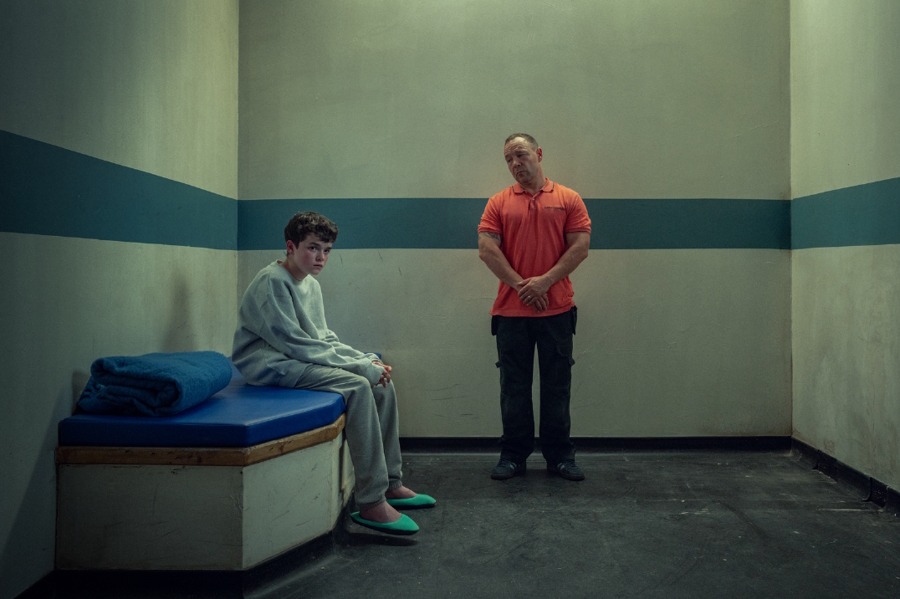
Photo:
The world boys grow up in is saturated with pressures to be macho, prove their worth through sex or violence, and bury vulnerability under hate and aggression. Photo courtesy of Netflix
Have you heard the buzz around Netflix’s new series “Adolescence”? At first glance, it seems like a story about a boy murderer. Upon closer examination, it’s really about the world boys grow up in — saturated with pressures to be macho, prove their worth through sex or violence, and bury vulnerability under hate and aggression.
Yes, gender stereotypes have always harmed boys and girls alike. But now, much of the damage happens online, out of sight and supercharged. Parents need to know about it.
Both victim and perpetrator
The boy murderer in “Adolescence” is as much a victim as a perpetrator. At 13, Jamie is doing what kids his age are wired to do: seek belonging, pull away from parents and figure out who they are. As they become more private, they look beyond family for cues about what traits are desirable — and which are shamed.
You did it. I did it. Most parents did a version of it, whether we admit it or not. We may have roamed neighborhoods, smoked in secret or snuck out for fun. Aggression or cruelty may have occurred, but the risks of the past were different — today’s dangers lie in the twilight zone of social media.
According to Gallup, the average teen now spends five hours a day on social media. That’s 35 hours a week. Imagine if even some of that time went toward in-person friendships, activities or screen-free downtime. If it had not been such a stealthy creep of this trend of tech-takeover, we’d all be screaming about this massive digital kidnapping of our children. Some of us are.

Smartphones: A gateway drug
Parents hand over smartphones for good reasons — communication, convenience and peace. But these good reasons are paired with portals into dangerous wormholes, where a child’s sense of self can be distorted in minutes.
One study found that fake teen boy accounts on TikTok and YouTube were flooded with misogynistic, anti-LGBTQ and male-supremacist content within nine minutes — often through influencers like the Tate brothers. What started with innocent searches like “gaming” or “gym tips” escalated quickly into toxic messaging that exploits boys’ insecurities.
What happened to Jamie in the show is extreme, but many boys have experienced versions of it since smartphones went into the hands of most teens around 2011. In 2018 I wrote “How Boys Suffer: The Boy Code and Toxic Masculinity” for ParentMap. Netflix’s “Adolescence” is the next stage — and things have worsened.
What boys like Jamie need the most: connection, self-worth and social-emotional skills that lead to success in work, love and life.
The boy code demands boys be tough, dominant, and suppress feelings of vulnerability or weakness. Aggression is lauded. Success is mandatory. Femininity? Rejected. True manhood? Subordination of females.
Note the disdain for anything feminine. NPR recently reported that empathy is now viewed as a weakness in many sectors, and a female trait, which is considered a liability.
Why the female-hating?
Girls continue to outperform boys in school. The gender ratio among college and postcollege graduates compared to those that top out at high school has flipped from 70/30 male to female, to 70/30 female to male in just 50 years.
This trend starts early. School tends to favor traits such as verbal skills and self-regulation, which girls often develop earlier. Boys who are restless or disruptive may struggle and seek validation elsewhere — like the manosphere.
Many young men not heading to college feel the world isn’t built for them. They flounder to find purpose, connection and a role in a society that’s shifting rapidly. Why do you think Melinda French Gates — longtime advocate for girls — gave $20 million to the American Institute of Boys and Men last year? Because we can’t have thriving girls and women if boys and men are falling behind.
Girls face their own digital pressures. As smartphones became hand extensions, depression, anxiety, self-harm and eating disorders among teen girls spiked. Social media pressures girls to be perfect, hot and popular. LGBTQ youth suffer the most, with unique vulnerabilities and higher risks.
Girls can be cruel, too. Jamie gets humiliated bigtime by a girl on Instagram, and when this happens in conjunction with the boy herd belittling him about his manhood — virility and virginity — bad things happen.
Seeds of toxic masculinity
By the time Jamie gets slimed on social media, his self-worth is devoid of any sense of value. But his internalized self-loathing started earlier. He wasn’t sporty like Dad wanted him to be. He lacked both models for sharing tender emotions and connections to people who valued him for his non-macho strengths like drawing. Even the fact that he was a good student didn’t matter much in his world.
Online toxins go beyond social media. There’s porn, violent gaming and the erosion of in-person interaction. By high school, many boys have lost thousands of hours of face-to-face contact. Some become incels — involuntarily celibate — and lash out with misogynistic rage, fueled by online influencers.
Algorithms push porn involving horrendous physical abuse and exploitation of women. Gaming online can be fun and involve positive social connections, but what about the unrelenting stream of profanity, with distinctly female vulgarities like the c-word, the p-word and the b-word? Kids will tell you it doesn’t matter. It does.
Why is such abuse easier online? Anonymity, code words and nighttime impulsivity. Even attentive parents may miss it. The herd mentality, fueled by dopamine and boredom, takes over.
Bullying can mushroom into new levels of terrible on social media. “Go ahead. Kill yourself. Be brave!” Really? Andrew Soloman discussed the teen mental health crisis in his article about social media and suicide for The New Yorker last year.
Why is such abuse easier online? Anonymity, code words and nighttime impulsivity. Even attentive parents may miss it. The herd mentality, fueled by dopamine and boredom, takes over.
Where are the parents in all this? Even caring parents can be naïve about the boy code and the depth of boys’ suffering. We can downplay the rising levels of misogyny or think it’s a “woke” thing. Almost all of us think our sons are more innocent to this stuff than they are. And who doesn’t feel overwhelmed by tech advances and cyberspace? But in the thick of it, there are ways parents can protect and support their sons.
Steps to protect boys from toxic versions of masculinity
- Know their worlds. Understand your son’s social media, peer and tech life. Rules, oversight and effort are required.
- Stay connected. Even as your son pulls away, pursue closeness — gently and on their terms.
- Model emotional vulnerability. Share feelings like embarrassment, sadness and self-doubt. Kids learn by example.
- Resist phone-based childhoods. Encourage free-range play, and pressure lawmakers to hold tech companies accountable for their known harms to children.
- Insist on real-world involvement. Encourage your 11- to 18-year-olds to participate in sports, hobbies, volunteering or other in-person activities that build character and social skills.
- Talk about tough topics and use current events as a prompt. From Andrew Tate to the war on empathy, discuss current events with curiosity — not lectures. Listen more, talk less.
- Support social-emotional learning (SEL) in schools. SEL boosts mental health but faces backlash. It empowers kids.
- Surround your son with male role models who respect females, express emotions openly and model positive masculinity.
What is positive masculinity?
It’s expressing traditional masculine traits — like strength, leadership and protectiveness — in ways that are emotionally healthy, respectful and grounded in empathy and integrity.
No one in the manosphere is teaching this. But it’s what boys like Jamie need the most: connection, self-worth and social-emotional skills that lead to success in work, love and life.
More ways to support our kids:
Looking for more? Be sure to check out ParentMap’s The Antidote for the Anxious Generation page for more information and resources. |
Editor's note: Common Sense Media has taken note of "Adolescence" and the discussions around the series. In response, they're encouraging Congress to take action and inviting others to join the effort. In their own words:
"The gripping new Netflix show Adolescence is making waves, telling the story of a teenage boy in the U.K. who's arrested on suspicion of murdering his classmate. It's a chilling look at the dark side of social media, teen relationships, and the toxic online environments kids navigate daily.
Adolescence is more than just a tense binge-watch. It's a wake-up call.
Social media platforms can be hotbeds of harmful content, spreading violent and sexual content and reinforcing toxic forms of masculinity. That's because algorithms are expressly designed to push teens toward content that keeps them engaged. We can't allow tech companies to continue profiting from platforms that endanger the next generation. That's why we're launching an important new petition, spurred on by the deep interest in this new show, calling on Congress to take decisive action."
If you are interested, you can find and sign the Common Sense Media petition online.











